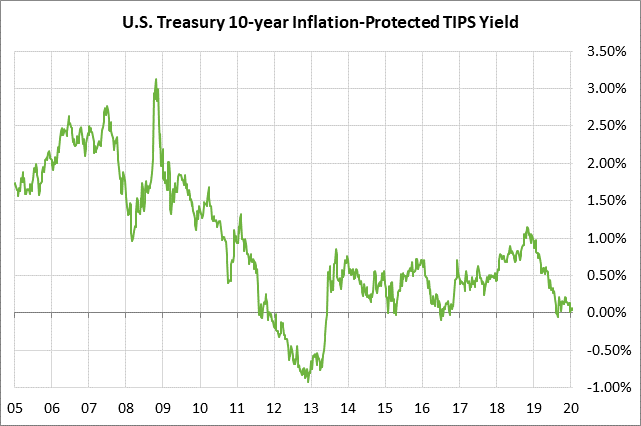- President Trump wants EU trade deal before the election
- US/France reach digital-tax truce
- U.S. locks in Feb 14 tariff cut to comply with US/China phase-one agreement
- Italian bond yield remains stable despite increased risk of snap election
- ECB today will announce its policy review
- U.S. LEI expected to be weak
- 10-year TIPS auction
President Trump wants EU trade deal before the election — President Trump on Wednesday in Davos said that he wants a trade deal with Europe before November’s election. He said he has a deadline in mind but refused to make it public. Mr. Trump again threatened to slap tariffs on European autos if there is no US/EU trade deal.
EU Commission President Ursula von der Leyen will travel to Washington in February for talks that will include trade relations. The U.S. and EU have been in an uneasy trade truce since July 2018 and have yet to begin talks on a trade deal involving industrial products and autos because the EU refuses to include agriculture in the trade talks.
Mr. Trump clearly plans to focus his firepower on European trade this year, but it remains to be seen whether he will impose tariffs on European autos during the campaign season since that would raise the price of European autos for U.S. consumers and put a significant dent in the global auto industry and auto stocks.
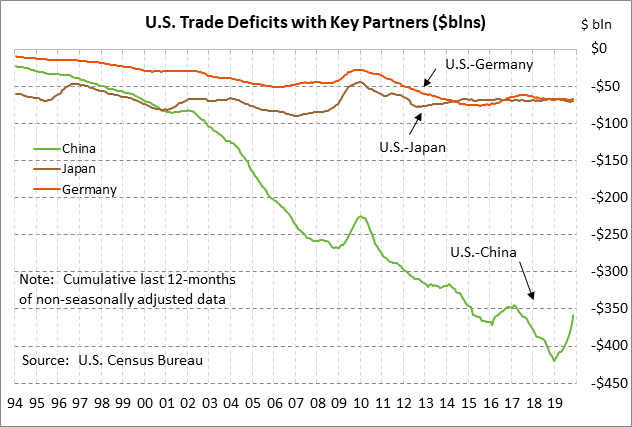
US/France reach digital-tax truce — French Finance Minister Le Maire on Wednesday said that he and Treasury Secretary Mnuchin reached an agreement on France’s digital tax whereby the U.S. will back off on its threat of tariffs on $2.4 billion of French goods. France agreed to delay collecting the digital tax until the end of 2020.
However, Mr. Le Maire said that France will not withdraw its digital tax and plans to proceed with the tax if no agreement is reached at the OECD level for a globally-acceptable digital tax structure. The Trump administration seems unlikely to agree to any global agreement for a digital tax, which would fall mostly on U.S. tech companies.
The digital sales tax idea is likely to cause more problems during 2020 since the Trump administration is threatening to slap tariffs on any country that adopts the tax. Both the UK and Italy are considering a digital tax.
U.S. locks in Feb 14 tariff cut to comply with US/China phase-one agreement — The U.S. Trade Representative’s office on Wednesday filed the notice in the Federal Register necessary to implement the tariff cut promised in the US/China phase-one trade agreement. The U.S. will cut the 15% tariff to 7.5% on $120 billion of Chinese goods effective on Feb 14. Under the trade agreement, the 25% tariff on the original $250 billion of Chinese goods will remain in place.
In some positive US/China trade news on Wednesday, Treasury Secretary Mnuchin said that there is no deadline for beginning the phase-two talks. The markets are hoping that President Trump will take a more relaxed approach to the phase-two talks that do not involve any new threats to US/China trade relations before the November election.
Italian bond yield remains stable despite increased risk of snap election — The leader of Italy’s Five Star Movement party, Luigi Di Maio, announced his resignation as party chief on Wednesday. Italy is currently governed by the unlikely coalition of the Five Star Movement and the Social Democrats. There are fears that the weakening of the Five Star party will splinter the coalition and lead to snap elections, which the League would be likely to win. A new government run by the League would be a wild card for the markets since League leader Salvini has already had a major run-in with the EU about his budget-busting fiscal plan for 2019 when he was part of the government.
The markets are braced for elections this weekend in the Emilia Romagna area of Italy. If the League does well in this weekend’s elections, that could accelerate the move towards a snap election.
The Italian bond market is not too worried as yet. Italy’s 10-year bond yield on Wednesday actually fell by -2 bp to 1.35% and remained 9 bp below last week’s 5-month high of 1.44%. The spread of the Italian 10-year bond yield over German bunds was little changed at 161 bp, remaining within its narrow 2-month range.
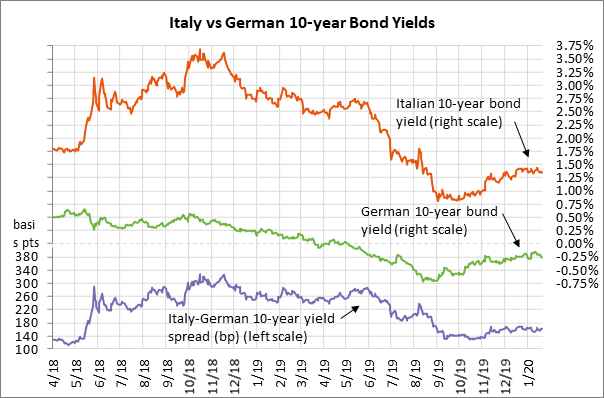
ECB today will announce its policy review — The ECB at its meeting today is unanimously expected to leave its policy variables unchanged with the refinancing rate at zero and the deposit rate at -0.50%. The ECB on November 1 restarted its QE program with 20 billion euros of bond purchases per month. The markets are not expecting an ECB rate hike for at least 1-2 years.
The main news from today’s ECB meeting will be the announcement of the ECB’s review of its overall monetary policy, which is expected to be completed by the end of the year. The review could result in a slight dovish shift in the ECB’s inflation target. The ECB may change its inflation target from “close to but below 2%” to a symmetrical 2% target such as the target seen in other major countries such as the United States. A symmetrical target would make it clearer that the ECB would like Eurozone inflation to periodically move above 2.0%.
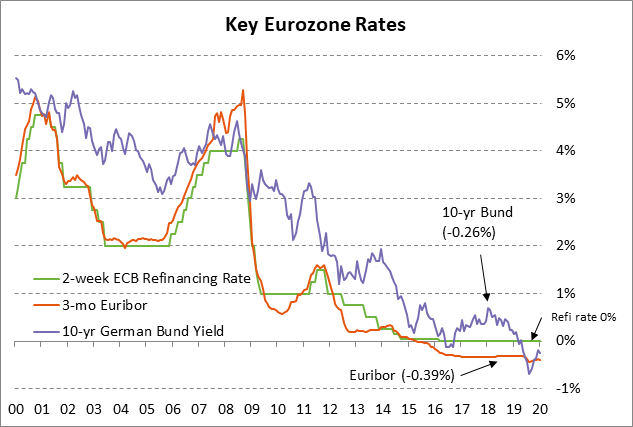
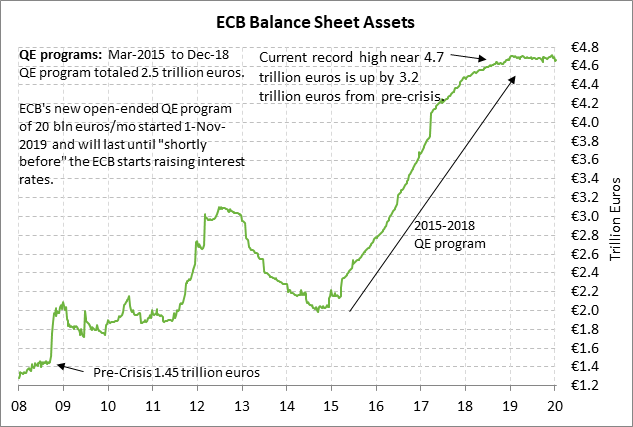
U.S. LEI expected to be weak — Today’s Dec U.S. LEI is expected to show continued weakness with a -0.2% m/m decline, which would be the fourth decline in the past five months. On a year-on-year basis, the LEI in Nov fell to a 10-year low of +0.1% y/y, the weakest level since the LEI climbed out of negative territory in 2009 after the Great Recession. The consensus is for U.S. GDP growth to decelerate to +1.8% in 2020 from +2.3% in 2018 and +2.9% in 2018.
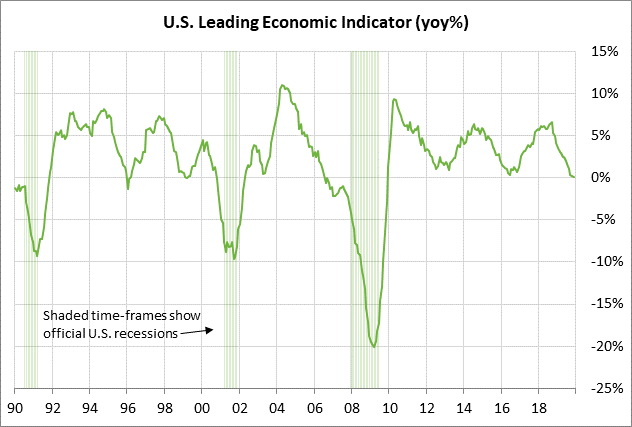
10-year TIPS auction — The Treasury today will sell $14 billion of 10-year TIPS. The 10-year TIPS yield yesterday closed at 0.021%, just 1.4 bp above the early-Jan 4-month low of 0.007%.
